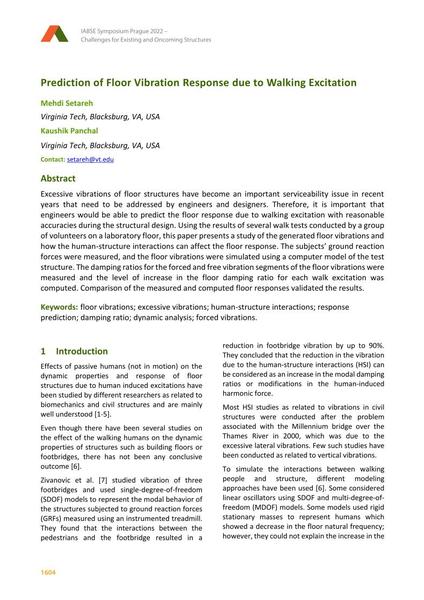Prediction of Floor Vibration Response due to Walking Excitation

|
|
|||||||||||
Bibliographic Details
| Author(s): |
Mehdi Setareh
(Virginia Tech, Blacksburg, VA, USA)
Kaushik Panchal (Virginia Tech, Blacksburg, VA, USA) |
||||
|---|---|---|---|---|---|
| Medium: | conference paper | ||||
| Language(s): | English | ||||
| Conference: | IABSE Symposium: Challenges for Existing and Oncoming Structures, Prague, Czech Republic, 25-27 May 2022 | ||||
| Published in: | IABSE Symposium Prague 2022 | ||||
|
|||||
| Page(s): | 1604-1610 | ||||
| Total no. of pages: | 7 | ||||
| DOI: | 10.2749/prague.2022.1604 | ||||
| Abstract: |
Excessive vibrations of floor structures have become an important serviceability issue in recent years that need to be addressed by engineers and designers. Therefore, it is important that engineers would be able to predict the floor response due to walking excitation with reasonable accuracies during the structural design. Using the results of several walk tests conducted by a group of volunteers on a laboratory floor, this paper presents a study of the generated floor vibrations and how the human-structure interactions can affect the floor response. The subjects’ ground reaction forces were measured, and the floor vibrations were simulated using a computer model of the test structure. The damping ratios for the forced and free vibration segments of the floor vibrations were measured and the level of increase in the floor damping ratio for each walk excitation was computed. Comparison of the measured and computed floor responses validated the results. |
||||
| Keywords: |
dynamic analysis Damping Ratio Human-Structure Interactions Excessive Vibrations floor vibrations response prediction forced vibrations
|
||||
| Copyright: | © 2022 International Association for Bridge and Structural Engineering (IABSE) | ||||
| License: | This creative work is copyrighted material and may not be used without explicit approval by the author and/or copyright owner. |
||||
